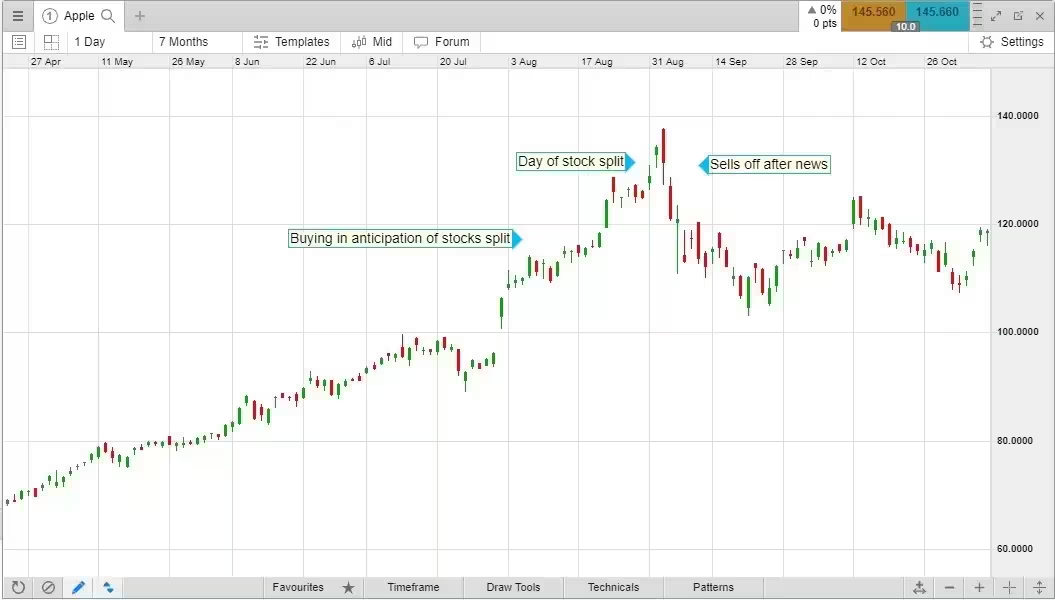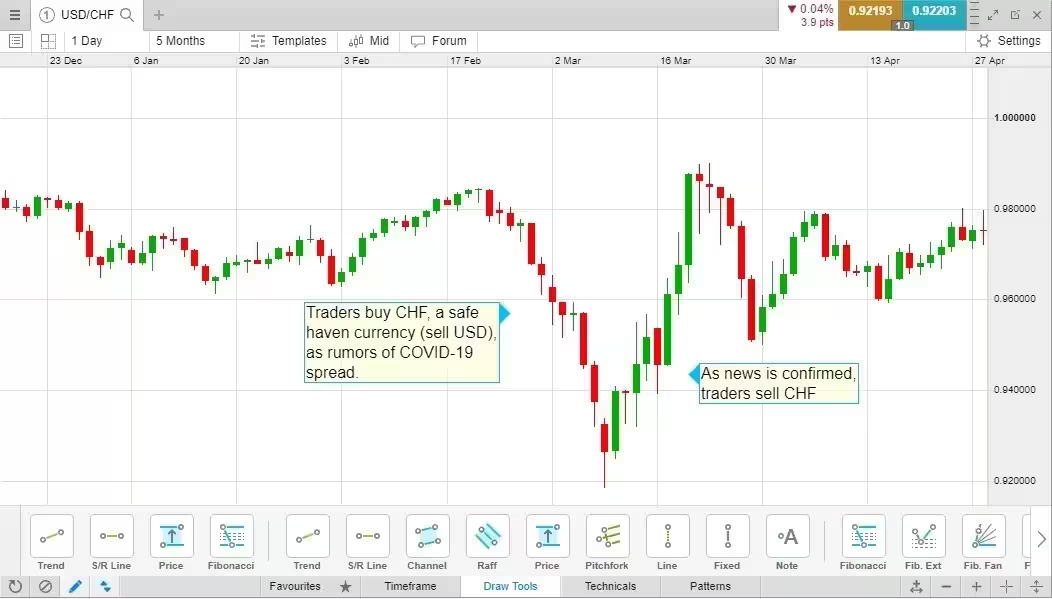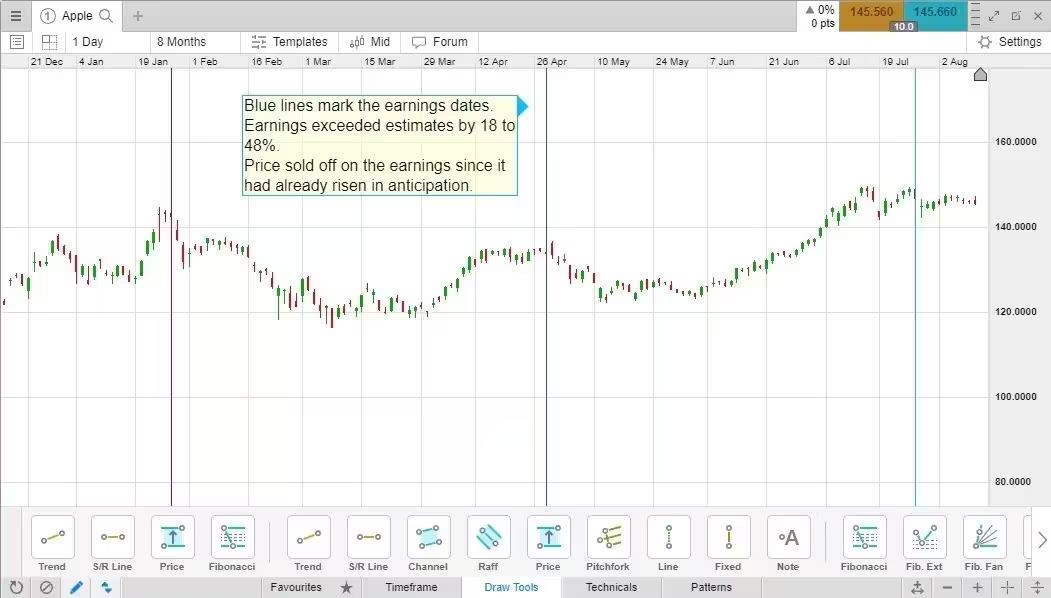
Buy the rumour, sell the news strategy explained
What does it mean when traders and investors talk about ‘buy the rumour, sell the news’? And how can you use this strategy to trade on earnings and interest rate announcements, the forex market, or anywhere there is a risk event? Read on to learn how the buy the rumour and sell the news strategy works, see examples, and learn how to find the rumours/news to trade.
What does buy the rumour, sell the news mean?
‘Buy the rumour, sell the news’ is a well-worn expression, and in the context of trading, it means that if good news is expected sometime in the future, the price will often move higher in anticipation of that date, but not necessarily after.
Market pricing tends to move in anticipation of something happening – the rumour. By the time the event happens, most people who want to own the stock or currency already do. This means that when the event occurs, there is no one left to buy and keep pushing the price up. This leads people to sell, trying to cash in their profit.
In the same way, if positive news comes out and a stock or other asset drops on the news, traders will say, “the information was already baked in”. What they are referring to is the fact that the price rise happened before the news, so the price of the asset already reflects the impact of that good news.
How does buy the rumour, sell the news work?
People tend to buy in the days and weeks leading up to an event that is supposed to be favourable for the security in question. For a stock, the event could be an earnings report or a stock split. For a currency, it could be an expected rise in interest rates.
Strategies for buying the rumour and selling the news
Trading on a stock split
In mid-2020, Apple announced that it was going to do a stock split. Stock splits increase the number of shares outstanding but reduce the stock price. Stocks splits are typically viewed favourably since the reduced price tends to draw in more investors and increase volume, even though nothing has fundamentally changed in the company.
The price of Apple’s stock rose more than 40% in the month leading up to 31 August 2020, the day of the stock split. Analysts and traders were buzzing about how the split would help fuel the price higher, and as investors piled in, by the time the stock split happened, everyone who wanted to own it was on board. Over the three weeks following the split, the stock fell more than 20%.

Trading in the forex market
When fears of the Covid-19 pandemic began to surface in February 2020, there was a financial shock. Yet, traders still bought the rumour and sold the news. They assumed that the pandemic would be a global problem, so they bought safe-haven currencies like the Japanese yen (JPY) and Swiss franc (CHF).
The USD/CHF tumbled as fears mounted about coronavirus, and traders bought the CHF (and sold USD). While the impact of Covid-19 lasted a long time, the rumour didn’t. The USD/CHF fell for only two weeks. As more data was released about the severity of the virus, the price completely recovered the decline. Traders who were trading the news bought the rumour by buying the CHF and then sold it right back as more news came out.

Trading on earnings announcements
Since Apple is such a highly followed company and tends to perform well, its earnings announcements can be traded. During the first three earning releases of 2021, the stock rose in the month leading up to the announcements. This was buying the rumour, as traders expected that Apple would post good earnings. And it did, beating analyst estimates by 18% to 48%. And yet, each time, right after earnings, the price fell. Traders were already expecting good numbers and bought based on that expectation. When the earnings were released, selling increased because the up move had already happened.

What events can I use this strategy with?
Traders use a buy the rumour and sell the news tactic when there is a highly anticipated event in the future. Such events may include:
Economic indicators, such as employment or inflation numbers. These data reports tend to have a significant impact since they provide information on what is happening with the economy.
Earnings announcements have a pre-set date, and analysts try to predict what a company’s earnings will be. Traders may “buy the rumour” if the earnings are expected to be good.
A company announcing that it will unveil a new product in the future creates hype, and people may buy the stock in anticipation of the new product.
Central banks make interest rate announcements at regular intervals. Analysts evaluate the probabilities that the central bank will raise or lower rates. Traders may take a position based on these assumptions.
In these cases, a trader is buying because the expectation is that the future announcement or data point will be positive. The strategy says to sell when the actual news comes out, assuming it is close to what was expected.
If the news is much better than expected, the trader may decide not to sell, since the better-than-expected news may lure in additional buyers, helping to push the price up even more.
How to buy the rumour, sell the news
Open a trading account. You will automatically be granted access to a free demo account where you can practise trading risk-free with virtual money.
Choose your product between spread betting and CFD trading.
Look for high-impact upcoming news announcements. For ideas, see our economic calendar.
Determine, based on consensus estimates, whether the news is expected to be favourable. Do your due diligence and determine if the asset warrants purchasing in advance of the news or short selling after the event.
Consider placing a stop-loss order to control risk.
Where to find interest rate expectation pricing
For traders interested in trading on interest rate announcements, which can have a significant impact on stocks, forex, and bond markets, here’s how to find out what interest rates are expected to do in the future. It is the expectation that often drives prices. For example, if the Bank of England is expected to raise interest rates, that may push the British pound (GBP) higher against other currencies. This rise may occur before the rate is raised.
The Chicago Mercantile Exchange (CME) publishes the probabilities of what the US Federal Reserve and Bank of England are likely to do at their upcoming meetings. For example, if no change is expected, then it may say there is a 100% chance that interest rates will stay at the current rate. If there is a 50% chance rates will be raised, the expected rate and current rate will show a 50% probability.
How to front-run earnings reports
If a company is expected to have a very positive earnings report, some traders will buy prior to the announcement because they know others will also be buying into the hype. If earnings come out as expected or worse, they may sell. If earnings are much better than analyst expectations, a trader may hold on as the positive news may surprise people and bring new buyers in.
A trader may also use one company’s earnings to help predict what may happen with the earnings reports of other companies in the same industry.
For example, Snapchat reported earnings 44% better than expected in July 2021. Twitter also reported better than expected earnings.
Even though earnings from Alphabet and Facebook weren’t due out for several days, these stocks also jumped following the Snapchat news, since traders assumed that companies with similar business models such as Facebook and Alphabet would also be able to beat earnings estimates. Subsequently, the price of Facebook and Alphabet rallied into earnings and then declined when earnings came out. Traders bought the rumour, baking into the price the fact that earnings were likely to be good. When good earnings came out, traders sold the stock and collected their profits.
While analyst opinions and consensus estimates are useful, traders could also look to a “whisper number.” This is what traders believe is likely to happen as new information comes out. For example, after Snapchat and Twitter posted better than expected earnings, traders assumed (“whispered”) that Facebook and Alphabet would too. This information got baked into the stock price, resulting in a rise ahead of earnings.
We offer a dedicated news and analysis section that is updated daily with information about a wide range of topics, including economic indicators and earnings releases. You could also look to reputable financial sources online, such as Financial Times and Bloomberg.
The same process applies to front-running news as it does to front-running earnings or interest rate announcements. Isolate a future data point that is expected to be highly beneficial for a securities’ price. Some traders may prefer buying prior to the news release, and then consider selling if the news comes out as expected or worse. If it is better than expected, they may see if the price continues to rise. Learn more about market manipulation strategies.
*Tax treatment depends on individual circumstances and can change or may differ in a jurisdiction other than the UK.
Disclaimer: CMC Markets is an execution-only service provider. The material (whether or not it states any opinions) is for general information purposes only, and does not take into account your personal circumstances or objectives. Nothing in this material is (or should be considered to be) financial, investment or other advice on which reliance should be placed. No opinion given in the material constitutes a recommendation by CMC Markets or the author that any particular investment, security, transaction or investment strategy is suitable for any specific person. The material has not been prepared in accordance with legal requirements designed to promote the independence of investment research. Although we are not specifically prevented from dealing before providing this material, we do not seek to take advantage of the material prior to its dissemination.

